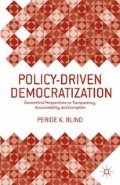Abstract
Transparency is not a commonly studied concept in either political science or public administration, especially when compared to the voluminous research on democratization, accountability and corruption. Its entry into the social sciences lexicon can be traced back to the end of the Cold War in the 1990s and the third wave of democratization. The concomitant formation of the European institutions and the renewed interest in state at around the same time also contributed to the increased saliency of transparency in policy circles and the academia. As a result and with time, information disclosure and dissemination of data to citizens were hailed as significant tools for fighting corruption (Ball 2009). As a matter of fact, government transparency was first defined as a possible means of controlling corruption (Mauro 1995, Ades and Di Tella 1999, Sandholtz and Koetzle 2000, Treisman 2000, Montinola and Jackman 2002).
Access this chapter
Tax calculation will be finalised at checkout
Purchases are for personal use only
Preview
Unable to display preview. Download preview PDF.
Notes
FOIA/Ls have seldom been consistently implemented across different administrations, let alone different countries. With each change of administration in the United States, a new stand on freedom of information was announced by the Attorney-general of the incoming government. Even though during the Clinton administration, government agencies had to prove harm to justify withholding information, during the second Bush administration, it was acceptable to retain information based on legal justification. As for the differences across countries, some FOIA/Ls as in Zimbabwe and Belarus, might read more like secrecy acts rather than right-to-know clauses. See C. Coglianese et al., Transparency and Public Participation in the Rulemaking Process, Penn.: University of Pennsylvania Law School, 2008. Available at http://www.hks.harvard.edu/hepg/Papers/transparencyReport.pdf.
P. Birkinshaw, “Transparency as a Human Right,” in Transparency: The Key to Better Governance? edited by C. Hood and D. Heald, London: British Academy Publications Online: February 2012. Available at http://www.britishacademypublications.com/view/10.5871/bacad/9780197263839.001.0001/bacad-9780197263839-chapter-3
S. Aftergood, “Reducing Government Secrecy: Finding What Works,” Yale Law and Policy Review 27, 399 (2009): 399–416. Available at http://www.fas.org/sgp/eprint/aftergood.pdf
Copyright information
© 2014 Peride K. Blind
About this chapter
Cite this chapter
Blind, P.K. (2014). The Transparency Triangle: Differentiating Inputs, Outputs and Outcomes. In: Policy-Driven Democratization. Palgrave Macmillan, New York. https://doi.org/10.1057/9781137294784_3
Download citation
DOI: https://doi.org/10.1057/9781137294784_3
Publisher Name: Palgrave Macmillan, New York
Print ISBN: 978-1-349-45160-9
Online ISBN: 978-1-137-29478-4
eBook Packages: Palgrave Political Science CollectionPolitical Science and International Studies (R0)

